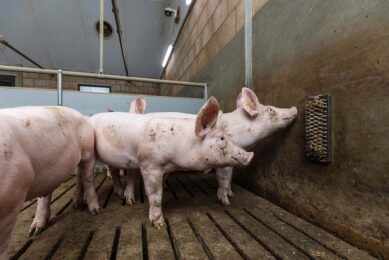The contrasting worlds of pig meat production

Most analyses dealing with the dynamics and patterns of global meat production focus on the leading countries and ignore the least developed countries (LLDC). This analysis takes a different perspective. How do the LLDC compare to the Champions League of pig production?
In 2018, 2.4 billion people, or 32% of the global population, lived in the 10 Champions League Countries (CLC). They contributed 73.6% to the global pig slaughter and 77.5% to global pig meat production. With 1.0 billion people, or 13.2% of the global population, the 38 LLDC that produced pig meat contributed 2.7% of the global pig slaughter and only 1.8% in pig meat production.
A closer look at the data reveals the drastic imbalance between the populations of the CLC and LLDC and their contribution to pig meat production. The population of the CLC was only about 2 times higher than that of the LDCs but their pig meat production volume was 43 times higher.
Of the 10 CLC, 3 were in Asia, 5 in Europe and 2 in the Americas. The 3 Asian countries contributed 47.9% of global production volume, the 5 European countries 14.8% and the 2 American countries 14.6%. Of the 38 LDCs, 27 were located in Africa, six in Asia, four in Oceania and only one in Central America. The six Asian countries contributed 1.04% to global pig meat production, the 27 African countries 0.74% and the American and Oceanian countries together 0.04%.
Pig slaughter and meat production in the CLC
In 2018, the 10 CLC slaughtered 1.1 billion pigs. The 3 Asian countries contributed 762.3 million head (67.7%), the five European countries 197.3 million head (17.5%) and the two American countries 167.1 million head (14.8%). The regional concentration in the group of the 10 CLC was very high. The three leading countries, China, USA and Germany, contributed 58.3% of the global pig slaughter, and 76.9% of the CLC group.
The 10 CLC produced 93.7 million tonnes of pig meat in 2018, 77.5% of the global production volume. The 2 Asian countries contributed 57.9 million tonnes or 61.8% of the total production volume of the CLC, the 3 American countries 17.9 million tonnes (19.2%) and the 5 European countries 17.8 million tonnes (19.0%). The regional concentration in pig meat production was higher than in pig slaughter. The 3 leading countries contributed 59.0% of the pig meat production.
A comparison of the composition and ranking of the ten countries in pig slaughter and pig meat production shows only minor changes. The Philippines were replaced by Canada and ranked as number nine among the top ten pig meat producing CLC. France climbed from rank 9 to rank 8. There was no change in the composition and ranking from rank 1-7, which demonstrates the stable situation in the leading countries.
Pig meat production in the LLDC
Table 1 shows the imbalance between the LLDC representation in the global population and their contribution to pig slaughter and pig meat production. A closer look at the situation at continent level (Table 4) reveals extraordinary differences.
In Africa, the 27 LLDC have 45.4% of the population but contributed 64.2% to pig slaughter and 56.3% to pig meat production. In Asia, the situation was more balanced although the 6 countries had a higher proprtion of the continent’s population than is reflected in pig meat production. This was also the case in Oceania. The wide gap indicates the very low standard of the pig meat industry. This was also the case in Haiti, the only LDC in the Americas.
In 2018, 40.8 million pigs were slaughtered in the 38 LLDC with pig production. The ten leading countries contributed 35.5 million head, or 86.5%, and Myanmar and Malawi together contributed 53.8% (see Table 5). The development of these two countries in the decade between 2008 and 2018 is of particular interest. The slaughter volume in Myanmar increased by 5.6 million head; in Malawi by 7.7 million head. The extraordinary growth in Malawi was due to a government development policy and capital investments in large operations by entrepreneurs. In Myanmar, the Thai company CP was the main driving force behind the remarkable increase.
The 38 LLDC produced 2.2 million tonnes of pig meat. The 10 leading countries contributed almost 2 million tonnes, or 89.7% (Table 5). The 2 leading countries, Myanmar and Malawi, contributed 1.3 million tonnes, or 60.6%, of the total production volume of the LLDC; the other 36 countries only 39.4%.
Outstanding role of Myanmar
This is an indicator of the extremely high regional concentration and the outstanding role of Myanmar. Pig meat production in this country grew by 600,000 tonnes or 129.5%. Parallel to the growth in pig slaughter, Malawi’s pig meat production increased by 234,000 tonnes in the decade between 2008 and 2018. The relative growth rate was the highest of all pig meat producing countries, at 688.2%. The already mentioned interaction between government planning and entrepreneurial investments led to this success.

Malawi’s share in the production volume of the LLDC group increased from 2.8% in 2008 to 12.2% in 2018. The 6 LLDC located in Asia contributed 57.4% of the production volume of this country group, the 27 African countries 40.7%. In Africa, no country reached a position as dominating as that of Myanmar in Asia.
Large differences in slaughter weights
Table 6 documents the average slaughter weights in the CLC and the ten leading LLDC. A comparison between the overall average shows a difference of 30kg, indicating the wide gap between the standard of the swine industry in the 2 country groups.
With the exception of Myanmar and Madagascar, all LLDC had an average below 70kg. Only Myanmar came close to the slaughter weights in the CLC. Of the 10 leading CLC, China and Vietnam fell far behind the other countries. This wide gap seems to be due to outbreaks of African Swine Fever (ASF). In 2008, the average slaughter weight in China was already 78.4kg and did not increase, in contrast to other CLC. In Vietnam, the average weight decreased by 2kg between 2008 and 2018. To avoid complete losses, some herds were slaughtered before reaching the intended live weight.
Considerable differences
A comparison of the slaughter weights in the 10 leading LLDC reveals considerable differences. The highest value was from Myanmar, which had 85.0kg, followed by Madagascar with 70.1kg and Angola with 65.0kg. In contrast, the slaughter weights were very low in Laos, which had 27.7kg; Malawi had 28.5kg and Burkina Faso 30.0kg. Even when considering the use of local breeds in backyard herds, a less efficient feed and the lack of a qualified veterinary service, the values seem to be too low. In Laos, the outbreaks of ASF may have caused the slaughter of pigs at a low weight to avoid complete loss of the herd.
Summary
The preceding analysis documented the large difference between the status of the swine industry in the leading industrialised countries and in the LLDC. In 2018, the 10 CLC had 32.0% of the global population but contributed 77.5% of pig meat production. In contrast, the 38 pig meat producing LLDC had 13.2% of the global population but contributed only 1.8% to pig meat production.
Despite the comparatively low importance of the LLDC in global pig meat production, the dynamic development in several countries is worth noting, in particular the extraordinary position of Myanmar and Malawi. In Africa, the LLDC contributed 56.3% to the continent’s pig meat production; in Asia, this was only 1.9% despite the very dynamic development in Myanmar.
References available on request.
* The author is scientific director, WING, Hanover Veterinary University and professor emeritus of the University of Vechta, Germany
 Beheer
Beheer








 WP Admin
WP Admin  Bewerk bericht
Bewerk bericht